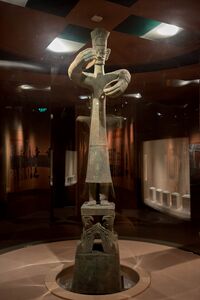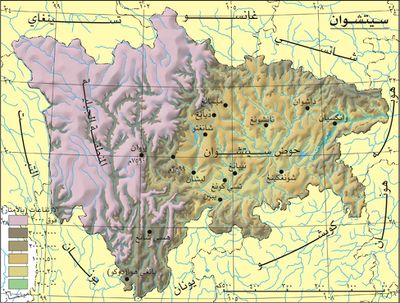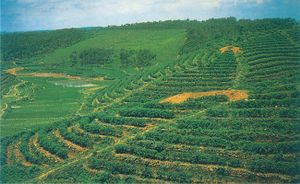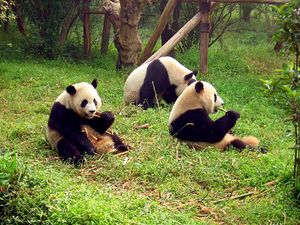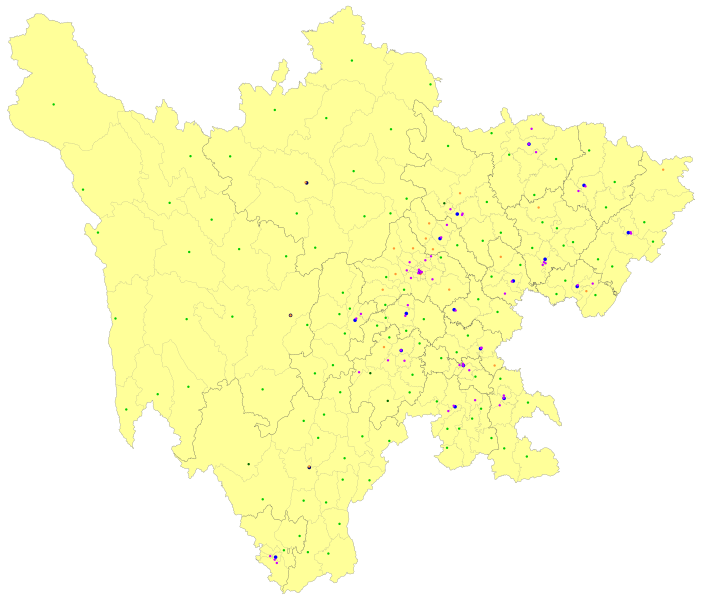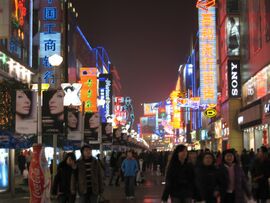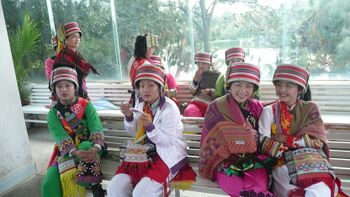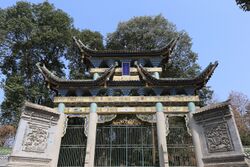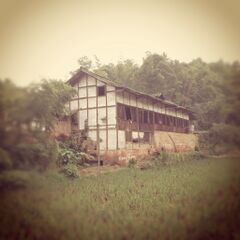سيتشوان
Sichuan
四川 | |
|---|---|
| مقاطعة سيتشوان | |
| الترجمة اللفظية بالـ Name | |
| • Chinese | 四川省 (Sìchuān Šěng) |
| • Abbreviation | SC / 川 (پنين: Chuān�) |
(مع عقارب الساعة من أعلى)
| |
 Map showing the location of Sichuan Province | |
| الإحداثيات: 30°30′N 102°30′E / 30.5°N 102.5°E | |
| البلد | الصين |
| العاصمة (وأكبر مدينة) | تشنگدو |
| Divisions | 21 prefectures، 181 ناحية، 5011 townships |
| الحكومة | |
| • النوع | مقاطعة |
| • الكيان | Sichuan Provincial People's Congress |
| • CCP Secretary | Wang Xiaohui |
| • Congress chairman | Wang Xiaohui |
| • Governor | Huang Qiang |
| • CPPCC chairwoman | Tian Xiangli |
| • National People's Congress Representation | 147 deputies |
| المساحة | |
| • الإجمالي | 485٬000 كم² (187٬000 ميل²) |
| ترتيب المساحة | 5th |
| أعلى منسوب | 7٬556 m (24٬790 ft) |
| التعداد (2020)[2] | |
| • الإجمالي | 83٬674٬866 |
| • الترتيب | 4th |
| • الكثافة | 170/km2 (450/sq mi) |
| • ترتيب الكثافة | 22nd |
| Demographics | |
| • Ethnic composition | Han – 95% Yi – 2.6% Tibetan – 1.5% Qiang – 0.4% Others – 0.5% |
| • اللغات واللهجات | Southwestern Mandarin (Sichuanese), Khams Tibetan, Hakka Chinese |
| ISO 3166 code | CN-SC |
| GDP (2021) | CNY 4.86 trillion USD 847 billion (6th) |
| • per capita | CNY 64,357 USD 10,120 (16th) |
| HDI (2019) | 0.734[3] (high) (23rd) |
| الموقع الإلكتروني | SC.gov.cn |
| سيتشوان | |||||||||||||||||||||||||||||||||||||||||||
|---|---|---|---|---|---|---|---|---|---|---|---|---|---|---|---|---|---|---|---|---|---|---|---|---|---|---|---|---|---|---|---|---|---|---|---|---|---|---|---|---|---|---|---|
 "سيتشوان" بالحروف الصينية | |||||||||||||||||||||||||||||||||||||||||||
| Chinese name | |||||||||||||||||||||||||||||||||||||||||||
| الصينية | 四川 | ||||||||||||||||||||||||||||||||||||||||||
| البريد | Szechwan | ||||||||||||||||||||||||||||||||||||||||||
| المعنى الحرفي | "السهول الأربعة"[4] | ||||||||||||||||||||||||||||||||||||||||||
| |||||||||||||||||||||||||||||||||||||||||||
| Tibetan name | |||||||||||||||||||||||||||||||||||||||||||
| التبتية | སི་ཁྲོན་ | ||||||||||||||||||||||||||||||||||||||||||
| |||||||||||||||||||||||||||||||||||||||||||
| Yi name | |||||||||||||||||||||||||||||||||||||||||||
| Yi | ꌧꍧ syp chuo | ||||||||||||||||||||||||||||||||||||||||||
| أسماء سابقة | |||||||||||||
|---|---|---|---|---|---|---|---|---|---|---|---|---|---|
| Ba (today's Chongqing municipalities) and Shu (today's Sichuan province) | |||||||||||||
| الصينية | 巴蜀 | ||||||||||||
| |||||||||||||
سيچوان أو سيتشوان (بالإنجليزية Sichuan ؛ /sɪtʃˈwɑːn/;[5] 四川 �, مندرينية: [sɹ̩̂.ʈʂʰwán]; پنين: Sìchuān�; الرومنة البديلة: Szechuan أو Szechwan) هي إحدى مقاطعات جمهورية الصين الشعبية، في جنوب غرب الصين وتحتل معظم حوض سيتشوان والطرف الشرقي لـهضبة التبت بين نهر جينشوا في الغرب، وجبال دابا في الشمال وهضبة يونگوي إلى الجنوب. عاصمة سيتشوان هي تشنجدو، ويبلغ عدد سكانها 83 مليون نسمة، نسمة في 2022 وهي ثالث أكبر مقاطعة صينية من حيث عدد السكان. تحد سيتشوان چينگهاي إلى الشمال الغربي، گانسو إلى الشمال، شآنشي إلى الشمال الشرقي، تشونگچينگ إلى الشرق، گويژو إلى الجنوب الشرقي، يوننان إلى الجنوب، ومنطقة التبت الذاتية إلى الغرب.
In antiquity, Sichuan was the home of the ancient state of Ba and the ancient kingdom of Shu. Their conquest by Qin strengthened it and paved the way for Qin Shi Huang's unification of China under the Qin dynasty. During the Three Kingdoms era, Liu Bei's state of Shu was based in Sichuan. The area was devastated in the 17th century by Zhang Xianzhong's rebellion and the area's subsequent Manchu conquest, but recovered to become one of China's most productive areas by the 19th century. During World War II, Chongqing served as the temporary capital of the Republic of China, making it the focus of the Japanese bombing. It was one of the last mainland areas captured by the People's Liberation Army during the Chinese Civil War and was divided into four parts from 1949 to 1952, with Chongqing restored two years later. It suffered gravely during the Great Chinese Famine of 1959–61 but remained China's most populous province until Chongqing Municipality was again separated from it in 1997.
The Han Chinese people of Sichuan speak distinctive Sichuanese dialects of Mandarin Chinese. The spicy Sichuan pepper is prominent in modern Sichuan cuisine, featuring dishes—including Kung Pao chicken and mapo tofu—that have become staples of Chinese cuisine around the world.
Sichuan is the 6th-largest provincial economy of China, the largest in Western China and the second largest among inland provinces after Henan. As of 2021, its nominal GDP was 5,385 billion yuan (US$847.68 billion), ahead of the GDP of Turkey of 815 billion.[6][7] Compared to a country, it would be the 18th-largest economy as well as the 19th most populous as of 2021.[8]
There are many panda stations in the province and large reserves for these creatures, such as the Chengdu Research Base of Giant Panda Breeding.
. . . . . . . . . . . . . . . . . . . . . . . . . . . . . . . . . . . . . . . . . . . . . . . . . . . . . . . . . . . . . . . . . . . . . . . . . . . . . . . . . . . . . . . . . . . . . . . . . . . . . . . . . . . . . . . . . . . . . . . . . . . . . . . . . . . . . . . . . . . . . . . . . . . . . . . . . . . . . . . . . . . . . . . .
الأسماء
It is commonly believed that the name Sichuan means "four rivers", and in folk etymology, this is usually taken to mean four of the province's major rivers: the Jialing, Jinsha (or Wu), Min, and Tuo.[9][10] According to historical geographer Tan Qixiang, "four rivers" is an erroneous interpretation of the place's name.[11] The name of the province is a contraction of the phrases Sì Chuānlù (四川路, "Four Plain Circuits") and Chuānxiá Sìlù (川峡四路, "Four Circuits of Chuanxia"),[note 1][12] referring to the division of the existing imperial administrative circuit in the area into four during the Northern Song dynasty, which were Yizhou, Lizhou, Zizhou, and Kuizhou.[13] The word chuan (川) here means "plain", not its normal meaning of "river" as popularly assumed.[14][15] In addition to its postal map and Wade-Giles forms, the name has also been irregularly romanized as Szű-chuan and Szechuan.
In antiquity, the area of modern Sichuan including the now separated Chongqing Municipality was known to the Chinese as Ba-Shu, in reference to the ancient state of Ba and the ancient kingdom of Shu that once occupied the Sichuan Basin. Shu continued to be used to refer to the Sichuan region all through its history right up to the present day; several states formed in the area used the same name, for example, the Shu of the Three Kingdoms period, and Former Shu and Later Shu of the Ten Kingdoms period.[16] Currently, both the characters for Shu and Chuan are commonly used as abbreviations for Sichuan.[17]
The region was formerly also referred to as "West China" or "Western China" by Protestant missions.
التاريخ
قبل التاريخ
The Sichuan Basin and adjacent areas of the Yangtze watershed were a cradle of indigenous civilizations dating back to at least the 15th century BC, coinciding with the Shang in northern China. The region had its own distinct religious beliefs and worldview. The earliest culture found in the region through archaeological investigation is the Baodun culture (ح.2700–1750 BC) excavated in the Chengdu Plain.[18][19]
مملكتا با و شو
أهم الدويلات الأصلية كانت با و شو.
Ba stretched into Sichuan from the Han Valley in Shaanxi and Hubei down the Jialing River as far as its confluence with the Yangtze at Chongqing.[20]
Shu occupied the valley of the Min, including Chengdu and other areas of western Sichuan.[20] The existence of the early state of Shu was poorly recorded in the main historical records of China. It was, however, referred to in the Book of Documents as an ally of the Zhou.[21] Accounts of Shu exist mainly as a mixture of mythological stories and historical legends recorded in local annals such as the Chronicles of Huayang compiled in the Jin dynasty (266–420),[22][23] and the Han-dynasty compilation zh (Chronicle of the Kings of Shu).[24] These contained folk stories such as that of zh (Duyu) who taught the people agriculture and transformed himself into a cuckoo after his death.[25] The existence of a highly developed civilization with an independent bronze industry in Sichuan eventually came to light with an archaeological discovery in 1986 at a small village named Sanxingdui in Guanghan, Sichuan.[25] This site, believed to be an ancient city of Shu, was initially discovered by a local farmer in 1929 who found jade and stone artefacts. Excavations by archaeologists in the area yielded few significant finds until 1986 when two major sacrificial pits were found with spectacular bronze items as well as artefacts in jade, gold, earthenware, and stone.[26] This and other discoveries in Sichuan contest the conventional historiography that the local culture and technology of Sichuan were undeveloped in comparison to the technologically and culturally "advanced" Yellow River valley of north-central China.
أسرة چين
The rulers of the expansionist state of Qin, based in present-day Gansu and Shaanxi, were the first strategists to realize that the area's military importance matched its commercial and agricultural significance. The Sichuan basin is surrounded by the Hengduan Mountains to the west, the Qin Mountains to the north, and Yungui Plateau to the south. Since the Yangtze flows through the basin and then through the perilous Three Gorges to eastern and southern China, Sichuan was a staging area for amphibious military forces and a haven for political refugees.[بحاجة لمصدر]
Qin armies finished their conquest of the kingdoms of Shu and Ba by 316 BC. Any written records and civil achievements of earlier kingdoms were destroyed. Qin administrators introduced improved agricultural technology. Li Bing, engineered the Dujiangyan irrigation system to control the Min River, a major tributary of the Yangtze. This innovative hydraulic system was composed of movable weirs which could be adjusted for high or low water flow according to the season, to either provide irrigation or prevent floods. The increased agricultural output and taxes made the area a source of provisions and men for Qin's unification of China.[بحاجة لمصدر]
أسرة هان
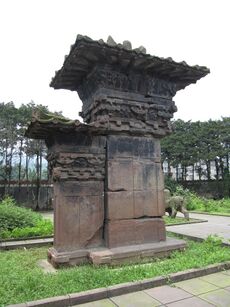
Sichuan was subjected to the autonomous control of kings named by the imperial family of the Han dynasty. Following the declining central government of the Han dynasty in the second century, the Sichuan basin, surrounded by mountains and easily defensible, became a popular place for upstart generals to found kingdoms that challenged the authority of Yangtze Valley emperors over China.[27]

. . . . . . . . . . . . . . . . . . . . . . . . . . . . . . . . . . . . . . . . . . . . . . . . . . . . . . . . . . . . . . . . . . . . . . . . . . . . . . . . . . . . . . . . . . . . . . . . . . . . . . . . . . . . . . . . . . . . . . . . . . . . . . . . . . . . . . . . . . . . . . . . . . . . . . . . . . . . . . . . . . . . . . . .
الممالك الثلاث
In 221, during the partition following the fall of the Eastern Han – the era of the Three Kingdoms – Liu Bei founded the southwest kingdom of Shu Han (蜀漢�; 221–263) in parts of Sichuan, Guizhou, and Yunnan, with Chengdu as its capital. Shu-Han claimed to be the successor to the Han dynasty.[27]
In 263, the Cao Wei of North China conquered the Kingdom of Shu-Han as a step on the path to reuniting China. Salt production becomes a major business in Ziliujing District. During the Six Dynasties period of Chinese disunity, Sichuan began to be populated by non-Han ethnic minority peoples, owing to the migration of Gelao people from the Yunnan–Guizhou Plateau to the Sichuan basin.[بحاجة لمصدر]
أسرة تانگ
Sichuan came under the firm control of a Chinese central government during the Sui dynasty, but it was during the subsequent Tang dynasty that Sichuan regained its previous political and cultural prominence for which it was known during the Han. Chengdu became nationally known as a supplier of armies and the home of Du Fu, who is sometimes called China's greatest poet. During the An Lushan Rebellion (755–763), Emperor Xuanzong of Tang fled from Chang'an to Sichuan which became his refuge. The region was torn by constant warfare and economic distress as it was besieged by the Tibetan Empire.[28]
الأسر الخمس والممالك العشر
In the Five Dynasties and Ten Kingdoms period, Sichuan became the centre of the Shu kingdom with its capital in Chengdu founded by Wang Jian. In 925 the kingdom was absorbed into Later Tang but would regain independence under Meng Zhixiang who founded Later Shu in 934. Later Shu would continue until 965 when it was absorbed by the Song.
أسرتا سونگ و يوان
During the Song dynasty (960–1279), Sichuanese was able to protect themselves from Tibetan attacks with the help of the central government. There were rebellions against the Song by Li Shun in 994 and Wang Jun in 1000. Sichuan also saw cultural revivals like the great poets Su Xun (蘇洵), Su Shi, and Su Zhe.[28] Although paper currency was known in the Tang dynasty, in 1023 AD, the first true paper money in human history, termed jiaozi (交子؛ jiāozǐ�), was issued in Chengdu.[29][30][31]
It was also during the Song dynasty that the bulk of the native Ba people of eastern Sichuan assimilated into the Han Chinese ethnicity.[32]
In the 12th and 13th centuries, the Southern Song dynasty established coordinated defenses against the Mongolian Yuan dynasty, in Sichuan and Xiangyang. The Southern Song state monopolized the Sichuan tea industry to pay for warhorses, but this state intervention eventually brought devastation to the local economy.[33] The line of defense was finally broken through after the first use of firearms in history during the six-year Battle of Xiangyang, which ended in 1273. Allegedly there were a million pieces of unspecified types of skeleton bones belonging to war animals and both Song and Yuan soldiers who perished in the fighting over the city, although the figure may have been grossly exaggerated.[34] The recorded number of families in Sichuan dropped from 2,640,000 families,[35] as recorded from the census taken in 1162 AD, to 120,000 families[36] in 1282 AD.[37] Possible causes include forced population transfer to nearby areas, evacuation to nearby provinces, census under-reporting or inaccuracy, and war-related deaths.[بحاجة لمصدر] One instance of the deportation of Sichuanese civilians to Mongolia occurred in the aftermath of a battle in 1259 when more than 80,000 people were taken captive from one city in Sichuan and moved to Mongolia.[38]
الجغرافيا
تقع مقاطعة سيشوان في حوض سيشوان الذي يحاط بجبال الهيمالايا من الغرب وكيلنج من الشمال ، ومنطقة ينان الجبلية من الجنوب. يعبر نهر يانجتز في مقاطعة سيشوان عابرا إلى منطقة غرب الصين. ويجري نهر منيج يانج في وسط سيشوان وهو أحد روافد نهر يانجتز ، حيث يلتقون في ييبين.
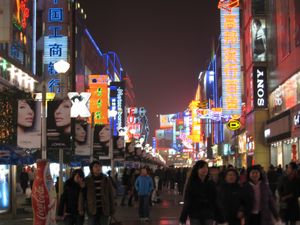
يقسم إقليم سيتشوان إلى وحدتين تضريسيتين، هما:
- الهضاب العالية والجبال المرتفعة، وتشمل الثلث الغربي من الإقليم. ترتفع معظم أراضي هذا الجزء إلى أكثر من 300م فوق مستوى سطح البحر، وأعلى نقطة فيه هي قمة جبل مينيا كونكا Minya Konka التي ترتفع إلى 7590م فوق سطح البحر، ويتميز بشدة تضرسه، لكثرة الوديان والحوضات فيه.
- حوض سيتشوان أو ما يعرف بالحوض الأحمر Red Basin، ويشغل نحو ثلثي مساحة الإقليم، إلى الشرق من الوحدة الأولى، وتحيط به الجبال المرتفعة من جميع الجهات تقريباً، ما عدا بعض الفتحات التضريسية في جباله الشرقية، وتتصرف مياهه عبر نهر يانغتسي وروافده المنحدرة شرقاً عبر أراضي الصين الوسطى والشرقية إلى بحر الصين. والحوض ذو تربة سميكة وخصبة، ولذا كان من أهم مناطق الصين الزراعية، وخاصة سهل شانغتو Changdu الذي تتوسطه المدينة التي تحمل الاسم نفسه.
المناخ في الحوض الشرقي ألطف من الجزء الغربي الجبلي، بسبب وقوعه في منأى من الهواء القطبي البارد شتاء الذي تصده الجبال العالية المحيطة به، ويصل فصل النمو في الحوض إلى 11شهراً، وربما طوال السنة، كما يتكرر فيه تشكل الضباب، وهو كثير الغيوم، وتقل فيه الرياح على نحو ظاهر، والرطوبة النسبية مرتفعة. أما الجبال الغربية فكثيرة الرياح، وقممها مغطاة بالثلوج مدة طويلة من السنة، بسبب غزارة الثلوج المتساقطة عليها شتاء، ولكن كمية الهطل فيها أقل من المنطقة الشرقية.
Larix potaninii in autumn colour.
Linpan in Chengdu Plain is a well-known landmark in Chengdu Plain, Sichuan.
. . . . . . . . . . . . . . . . . . . . . . . . . . . . . . . . . . . . . . . . . . . . . . . . . . . . . . . . . . . . . . . . . . . . . . . . . . . . . . . . . . . . . . . . . . . . . . . . . . . . . . . . . . . . . . . . . . . . . . . . . . . . . . . . . . . . . . . . . . . . . . . . . . . . . . . . . . . . . . . . . . . . . . . .
الپاندا العملاقة
Giant pandas live in bamboo forests and low mountainous areas such as the Minshan Mountains in Sichuan.[39] The majority of the panda population lives in Sichuan, with their range spreading into Shaanxi and Gansu. As it is abundant where they live, pandas' diet consists of 99% bamboo, with small other plants, or small animals consisting of the other 1%. As the panda is native to China, they have become a national symbol of China.[40]
المناخ
يعتبر مناخ مقاطعة سيشوان متغير للغاية ، ونستطيع أن نصف مناخ منطقة حوض سيشوان الذي يشمل مدينة شينجدو في الغرب ، بأنه مناخ شبه إستوائي (موسمي) دافي حار، مع صيف رطب وقصير ، وشتاء بارد جاف غائم. يتمتع الجزء الغربي من المقاطعة بطقس قاري يتميز بشتاء بارد جدا وصيف حار جدا ، مع كمية وفيرة من أشعة الشمس. الجزء الجنوبي من المقاطعة ، يتمتع بمناخ شبه إستوائي مع صيف ساخن وشتاء بارد للغاية.
السكان
تشكل قومية الهان الغالبية الساحقة من سكانها بحيث تبلغ نسبتهم 95% و 5% المتبقية من مختلف القوميات الأخرى وهم على النحو التالي :
الإقليم أحد أكثر الأقاليم الصينية كثافة سكانية، فهو يضم نحو 135مليون نسمة حسب تقديرات عام 2003، يتركز أكثر من 95% منهم في الحوض الأحمر، وهو الأكثر تنوعاً في مجموعاته العرقية، منها: الهان، اليي، المياو، الهوي (المسلمون) الصينيون، والشيانج، ويتوزع سكانه على ثلاث مجموعات لغوية، هي: لغة الماندرين الشمالية ويتكلم بها الصينيون، ولغة اليي ويتكلم بها التبتيون، ولغة الماندرين الجنوبية، ويتكلم بها المسلمون الذين يستخدمون العربية أيضاً في شعائرهم الدينية.
ومن أهم مدن الإقليم مدينة شانغتو وهي عاصمة الإقليم، وعدد سكانها نحو مليوني نسمة، تزوكنغ، يبين، نانشونغ، ياوان، كانغ تينغ، هسي شانغ، شـونغكنغ (3 مليون نسمة) Chongqing وكانت عاصمة الإقليم في الحرب العالمية الثانية.
التقسيمات الإدارية
Sichuan consists of twenty-one prefecture-level divisions: eighteen prefecture-level cities (including a sub-provincial city) and three autonomous prefectures:
| التقسيمات الإدارية لسيتشوان | |||||||||||
|---|---|---|---|---|---|---|---|---|---|---|---|
| Division code[41] | Division | Area in km2[42] | Population 2020[43] | Seat | Divisions[44] | ||||||
| Districts | Counties | Aut. counties | CL cities | ||||||||
| 510000 | Sichuan Province | 485,000.00 | 83,674,866 | تشنگدو city | 55 | 105 | 4 | 19 | |||
| 510100 | مدينة تشنگدو | 12,163.16 | 20,937,757 | Wuhou District | 12 | 3 | 5 | ||||
| 510300 | Zigong city | 4,373.13 | 2,489,256 | Ziliujing District | 4 | 2 | |||||
| 510400 | Panzhihua city | 7,423.42 | 1,212,203 | Dong District | 3 | 2 | |||||
| 510500 | Luzhou city | 12,233.58 | 4,254,149 | Jiangyang District | 3 | 4 | |||||
| 510600 | Deyang city | 5,951.55 | 3,456,161 | Jingyang District | 2 | 1 | 3 | ||||
| 510700 | Mianyang city | 20,267.46 | 4,868,243 | Fucheng District | 3 | 4 | 1 | 1 | |||
| 510800 | Guangyuan city | 16,313.70 | 2,305,657 | Lizhou District | 3 | 4 | |||||
| 510900 | Suining city | 5,323.85 | 2,814,196 | Chuanshan District | 2 | 2 | 1 | ||||
| 511000 | Neijiang city | 5,385.33 | 3,140,678 | Shizhong District | 2 | 2 | 1 | ||||
| 511100 | Leshan city | 12,827.49 | 3,160,168 | Shizhong District | 4 | 4 | 2 | 1 | |||
| 511300 | Nanchong city | 12,479.96 | 5,607,565 | Shunqing District | 3 | 5 | 1 | ||||
| 511400 | Meishan city | 7,173.82 | 2,955,219 | Dongpo District | 2 | 4 | |||||
| 511500 | Yibin city | 13,293.89 | 4 588 804 | Cuiping District | 3 | 7 | |||||
| 511600 | Guang'an city | 6,301.41 | 3,254,883 | Guang'an District | 2 | 3 | 1 | ||||
| 511700 | Dazhou city | 16,591.00 | 5,385,422 | Tongchuan District | 2 | 4 | 1 | ||||
| 511800 | Ya'an city | 15,213.28 | 1,434,603 | Yucheng District | 2 | 6 | |||||
| 511900 | Bazhong city | 12,301.26 | 2,712,894 | Bazhou District | 2 | 3 | |||||
| 512000 | Ziyang city | 7,962.56 | 2,308,631 | Yanjiang District | 1 | 2 | |||||
| 513200 | Ngawa Tibetan and Qiang Autonomous Prefecture | 82,383.32 | 822,587 | Barkam city | 12 | 1 | |||||
| 513300 | Garzê Tibetan Autonomous Prefecture | 147,681.37 | 1,107,431 | Kangding city | 17 | 1 | |||||
| 513400 | Liangshan Yi Autonomous Prefecture | 60,422.67 | 4,858,359 | Xichang city | 14 | 1 | 2 | ||||
| Administrative divisions in Chinese and varieties of romanizations | ||||
|---|---|---|---|---|
| English | Chinese | Pinyin | Sichuanese Romanzation | |
| Sichuan Province | 四川省 | Sìchuān Shěng | si4 cuan1 sen3 | |
| Chengdu city | 成都市 | Chéngdū Shì | cen2 du1 si4 | |
| Zigong city | 自贡市 | Zìgòng Shì | ||
| Panzhihua city | 攀枝花市 | Pānzhīhuā Shì | ||
| Luzhou city | 泸州市 | Lúzhōu Shì | nu2 zou1 si4 | |
| Deyang city | 德阳市 | Déyáng Shì | ||
| Mianyang city | 绵阳市 | Miányáng Shì | ||
| Guangyuan city | 广元市 | Guǎngyuán Shì | ||
| Suining city | 遂宁市 | Sùiníng Shì | xu4 nin2 si4 | |
| Neijiang city | 内江市 | Nèijiāng Shì | nui4 jiang1 si4 | |
| Leshan city | 乐山市 | Lèshān Shì | ||
| Nanchong city | 南充市 | Nánchōng Shì | lan2 cong1 si4 | |
| Meishan city | 眉山市 | Méishān Shì | mi2 san1 si4 | |
| Yibin city | 宜宾市 | Yíbīn Shì | ni2 bin1 si4 | |
| Guang'an city | 广安市 | Guǎng'ān Shì | ||
| Dazhou city | 达州市 | Dázhōu Shì | ||
| Ya'an city | 雅安市 | Yǎ'ān Shì | ||
| Bazhong city | 巴中市 | Bāzhōng Shì | ||
| Ziyang city | 资阳市 | Zīyáng Shì | ||
| Ngawa Tibetan and Qiang Autonomous Prefecture | 阿坝藏族羌族自治州 | Ābà Zangzú Qiāngzú Zìzhìzhōu | ||
| Garzê Tibetan Autonomous Prefecture | 甘孜藏族自治州 | Gānzī Zangzú Zìzhìzhōu | ||
| Liangshan Yi Autonomous Prefecture | 凉山彝族自治州 | Liángshān Yízú Zìzhìzhōu | ||
The twenty prefectures of Sichuan are subdivided into 183 county-level divisions (53 districts, 17 county-level cities, 109 counties, and 4 autonomous counties). At the end of the year 2017, the total population is 83.02 million.[45]
المناطق الحضرية
| التعداد حسب المناطق الحضرية للمحافظات ومدن النواحي | |||||
|---|---|---|---|---|---|
| # | City | Urban area[46] | District area[46] | City proper[46] | Census date |
| 1 | Chengdu[أ][ب] | 6,316,922 | 7,415,590 | 15,118,839 | 2010-11-01 |
| (1) | Chengdu (new districts)[أ] | 1,384,770 | 2,176,092 | see Chengdu | 2010-11-01 |
| 2 | Mianyang[ت] | 967,007 | 1,355,331 | 4,613,871 | 2010-11-01 |
| (2) | Mianyang (new district)[ت] | 96,265 | 366,802 | see Mianyang | 2010-11-01 |
| 3 | Nanchong | 890,402 | 1,858,875 | 6,278,614 | 2010-11-01 |
| 4 | Luzhou | 742,274 | 1,371,233 | 4,218,427 | 2010-11-01 |
| 5 | Leshan | 678,752 | 1,211,237 | 3,235,759 | 2010-11-01 |
| 6 | Zigong | 666,204 | 1,262,064 | 2,678,899 | 2010-11-01 |
| 7 | Panzhihua | 631,258 | 787,177 | 1,214,121 | 2010-11-01 |
| 8 | Neijiang | 586,445 | 1,251,095 | 3,702,847 | 2010-11-01 |
| 9 | Suining | 549,826 | 1,295,885 | 3,252,619 | 2010-11-01 |
| 10 | Yibin[ث] | 549,650 | 836,340 | 4,471,896 | 2010-11-01 |
| (10) | Yibin (new districts)[ث] | 277,993 | 1,148,864 | see Yibin | 2010-11-01 |
| 11 | Deyang[ج] | 530,122 | 735,070 | 3,615,758 | 2010-11-01 |
| (11) | Deyang (new district)[ج] | 79,269 | 212,185 | see Deyang | 2010-11-01 |
| 12 | Bazhong | 477,235 | 1,126,167 | 3283148 | 2010-11-01 |
| 13 | Xichang | 466,732 | 712,434 | part of Liangshan Prefecture | 2010-11-01 |
| 14 | Guangyuan | 407,756 | 859,246 | 2,484,122 | 2010-11-01 |
| 15 | Dazhou[ح] | 379,467 | 478,276 | 5,468,097 | 2010-11-01 |
| (15) | Dazhou (new district)[ح] | 299,223 | 1,111,159 | see Dazhou | 2010-11-01 |
| 16 | Ziyang[ب] | 376,387 | 905,729 | 2,593,843 | 2010-11-01 |
| 17 | Jianyang[ب] | 365,386 | 1,071,214 | see Chengdu | 2010-11-01 |
| 18 | Meishan[خ] | 347,546 | 821,853 | 2,950,545 | 2010-11-01 |
| (18) | Meishan (new district)[خ] | 150,350 | 285,889 | see Meishan | 2010-11-01 |
| 19 | Dujiangyan | 317,627 | 657,996 | see Chengdu | 2010-11-01 |
| 20 | Guang'an | 317,502 | 858,159 | 3,205,476 | 2010-11-01 |
| 21 | Jiangyou | 312,154 | 762,140 | see Mianyang | 2010-11-01 |
| (22) | Longchang[د] | 289,494 | 633,210 | see Neijiang | 2010-11-01 |
| 23 | Pengzhou | 263,199 | 762,887 | see Chengdu | 2010-11-01 |
| 24 | Langzhong | 242,535 | 728,935 | see Nanchong | 2010-11-01 |
| 25 | Guanghan | 235,872 | 591,115 | see Deyang | 2010-11-01 |
| 26 | Emeishan | 220,349 | 437,068 | see Leshan | 2010-11-01 |
| 27 | Ya'an[ذ] | 208,940 | 355,572 | 1,507,258 | 2010-11-01 |
| (27) | Ya'an (new district)[ذ] | 52,131 | 256,484 | see Ya'an | 2010-11-01 |
| 28 | Chongzhou | 206,448 | 661,120 | see Chengdu | 2010-11-01 |
| 29 | Mianzhu | 192,001 | 477,868 | see Deyang | 2010-11-01 |
| 30 | Qionglai | 190,099 | 612753 | see Chengdu | 2010-11-01 |
| 31 | Shifang | 187,473 | 412,758 | see Deyang | 2010-11-01 |
| 32 | Wanyuan | 129,617 | 407,594 | see Dazhou | 2010-11-01 |
| 33 | Huaying | 119,228 | 278,359 | see Guang'an | 2010-11-01 |
| (34) | Kangding[ر] | 60,439 | 130,142 | part of Garzê Prefecture | 2010-11-01 |
| (35) | Barkam[ز] | 28,783 | 58,437 | part of Ngawa Prefecture | 2010-11-01 |
- ^ أ ب New districts established after census: Shuangliu (Shuangliu County), Pidu (Pixian County). These new districts not included in the urban area & district area count of the pre-expanded city.
- ^ أ ب ت Jianyang CLC was transferred from Ziyang PLC to Chengdu PLC's jurisdiction after census; the City proper count is reflected onto Chengdu PLC not Ziyang PLC.
- ^ أ ب New district established after census: Anxian County). The new district not included in the urban area & district area count of the pre-expanded city.
- ^ أ ب New districts established after census: Nanxi (Nanxi County), Xuzhou (Yibin County). These new districts not included in the urban area & district area count of the pre-expanded city.
- ^ أ ب New district established after census: Luojiang (Luojiang County). The new district not included in the urban area & district area count of the pre-expanded city.
- ^ أ ب New district established after census: Dachuan (Daxian County). The new district not included in the urban area & district area count of the pre-expanded city.
- ^ أ ب New district established after census: Pengshan (Pengshan County). The new district not included in the urban area & district area count of the pre-expanded city.
- ^ Longchang County is currently known as Longchang CLC after census.
- ^ أ ب New district established after census: Mingshan (Mingshan County). The new district not included in the urban area & district area count of the pre-expanded city.
- ^ Kangding County is currently known as Kangding CLC after census.
- ^ Barkam County is currently known as Barkam CLC after census.
الاقتصاد

Sichuan is the 6th-largest provincial economy of China, the largest in Western China and the second largest among inland provinces after Henan. As of 2021, its nominal GDP was 5,385 billion yuan (US$847.68 billion), ahead of the GDP of Turkey of 815 billion.[6][7] Compared to a country, it would be the 18th-largest economy as well as the 19th most populous as of 2021.[8] As of 2021, its nominal GDP per capita was 64,357 RMB (US$10,120).[47] In 2021, the per capita net income of rural residents was 17,575 yuan (US$2760). The per capita disposable income of the urbanites averaged 41,444 yuan (US$6510).
يصنف إقليم سيتشوان بأنه إقليم زراعة الأرز الذي يكاد يزرع في عموم الصين، غير أن في الإقليم زراعات متنوعة، منها زراعة الذرة بأنواعها والبطاطا الحلوة والقمح والشعير وفول الصويا، إضافة إلى المحاصيل الأخرى مثل قصب السكر والقطن والتبغ والحرير والشاي والقنب، ومحاصيل ألياف أخرى، وتربى فيه أعداد كبيرة من الماشية والخنازير، وتتوافر فيه أنواع عدة من المعادن ومواد الطاقة، مثل الفحم والملح والبترول والغاز والحديد والنحاس والفسفور وقليل من الذهب. ويضم عدداً من الصناعات الكبرى، وفيه بعض المراكز الصناعية المهمة، منها: شونغكنغ، وفيها أكبر المصانع الكيمياوية ومصانع الحديد والصلب، وشانغتو وفيها مركز صناعة النسيج والصناعات الهندسية وصناعة كل ما يتعلق بالخطوط الحديدية، ونيكيانغ وفيها مركز صناعة سكر القصب، ويان وفيها مركز تحضير الشاي.[48]
Sichuan has been historically known as the "Province of Abundance". It is one of the major agricultural production bases of China. Grain, including rice and wheat, is the major product with output that ranked first in China in 1999. Commercial crops include citrus fruits, sugar cane, sweet potatoes, peaches, and grapes. Sichuan also had the largest output of pork among all the provinces and the second largest output of silkworm cocoons in 1999. Sichuan is rich in mineral resources. It has more than 132 kinds of proven underground mineral resources including vanadium, titanium, and lithium is the largest in China. The Panxi region alone possesses 13.3% of the reserves of iron, 93% of titanium, 69% of vanadium, and 83% of cobalt in the whole country.[49] Sichuan also possesses China's largest proven natural gas reserves (such as the Dazhou gas field), the majority of which are transported to more developed eastern regions.[50]
Sichuan is one of the major industrial centers of China. In addition to heavy industries such as coal, energy, iron, and steel, the province has also established a light industrial sector comprising building materials, wood processing, food, and silk processing. Chengdu and Mianyang are the production centers for textiles and electronics products. Deyang, Panzhihua, and Yibin are the production centers for machinery, metallurgical industries, and wine, respectively. Sichuan's wine production accounted for 21.9% of the country's total production in 2000.
Great strides have been made in developing Sichuan into a modern hi-tech industrial base, by encouraging both domestic and foreign investments in electronics and information technology (such as software), machinery and metallurgy (including automobiles), hydropower, pharmaceutical, food and beverage industries.
The auto industry is an important and key sector of the machinery industry in Sichuan. Most of the auto manufacturing companies are located in Chengdu, Mianyang, Nanchong, and Luzhou.[51]
Other important industries in Sichuan include aerospace and defense (military) industries. A number of China's rockets (Long March rockets) and satellites were launched from the Xichang Satellite Launch Center, located in the city of Xichang.
Sichuan's landscapes and rich historical relics have also made the province a center for tourism.
The Three Gorges Dam, the largest dam ever constructed, was built on the Yangtze River in nearby Hubei province to control flooding in the Sichuan Basin, neighboring Yunnan province, and downstream. The plan is hailed by some as China's efforts to shift towards alternative energy sources and to further develop its industrial and commercial bases, but others have criticised it for its potentially harmful effects, such as massive resettlement of residents in the reservoir areas, loss of archeological sites, and ecological damages.
الدخل الأدنى
Starting in 2021, the minimum wage in Sichuan Province will be 2,100 yuan ($330).
مناطق التنمية الاقتصادية
Chengdu Hi-tech Comprehensive Free Trade Zone
Chengdu Hi-tech Comprehensive Free Trade Zone was established with the approval of the State Council on October 18, 2010, and passed the national acceptance on February 25, 2011. It was officially operated in May 2011. Chengdu High-tech Comprehensive Free Trade Zone is integrated and expanded from the former Chengdu Export Processing Zone and Chengdu Bonded Logistics Center. it is located in the Chengdu West High-tech Industrial Development Zone, with an area of 4.68 square kilometers and divided into three areas A, B, and C. The industries focus on notebook computer manufacturing, tablet computer manufacturing, wafer manufacturing, chip packaging testing, electronic components, precision machining, and the biopharmaceutical industry. Chengdu Hi-Tech Comprehensive Free Trade Zone has attracted the top 500 multinational enterprises such as Intel, Foxconn, Texas Instruments, Dell, Morse, and so on.
In 2020, the Chengdu Hi-Tech Comprehensive Free Trade Zone achieved a total import and export volume of 549.1 billion yuan (including the Shuangliu Sub-zone), accounting for 68% of the province's total foreign trade import and export volume, ranking first in the national comprehensive insurance zone import and export volume for three consecutive years.
Chengdu Economic and Technological Development Zone
Chengdu Economic and Technological Development Zone (صينية: 成都经济技术开发区؛ پنين: Chéngdū jīngjì jìshù kāifā qū�) was approved as state-level development zone in February 2000. The zone now has a developed area of 10.25 km2 (3.96 sq mi) and a planned area of 26 km2 (10 sq mi). Chengdu Economic and Technological Development Zone (CETDZ) lies 13.6 km (8.5 mi) east of Chengdu, the capital city of Sichuan Province and the hub of transportation and communication in southwest China. The zone has attracted investors and developers from more than 20 countries to carry out their projects there. Industries encouraged in the zone include mechanical, electronic, new building materials, medicine, and food processing.[52]
Chengdu Export Processing Zone
Chengdu Export Processing Zone (صينية: 成都出口加工区؛ پنين: Chéngdū chūkǒu jiāgōng qū�)) was ratified by the State Council as one of the first 15 export processing zones in the country in April 2000. In 2002, the state ratified the establishment of the Sichuan Chengdu Export Processing West Zone with a planned area of 1.5 km2 (0.58 sq mi), located inside the west region of the Chengdu Hi-tech Zone.[53]
Chengdu Hi-Tech Industrial Development Zone
Established in 1988, Chengdu Hi-tech Industrial Development Zone (صينية: 成都高新技术产业开发区؛ پنين: Chéngdū Gāoxīn Jìshù Chǎnyè Kāifā Qū�) was approved as one of the first national hi-tech development zones in 1991. In 2000, it was open to APEC and has been recognized as a national advanced hi-tech development zone in successive assessment activities held by China's Ministry of Science and Technology. It ranks 5th among the 53 national hi-tech development zones in China in terms of comprehensive strength.
Chengdu Hi-tech Development Zone covers an area of 82.5 km2 (31.9 sq mi), consisting of South Park and West Park. By relying on the city sub-center, which is under construction, South Park is focusing on creating a modernized industrial park of science and technology with scientific and technological innovation, incubation R&D, modern service industry, and Headquarters economy playing leading roles. Priority has been given to the development of the software industry. Located on both sides of the "Chengdu-Dujiangyan-Jiuzhaigou" golden tourism channel, the West Park aims at building a comprehensive industrial park targeting industrial clustering with complete supportive functions. West Park gives priority to three major industries i.e. electronic information, biomedicine, and precision machinery.[54]
Mianyang Hi-Tech Industrial Development Zone
Mianyang Hi-Tech Industrial Development Zone was established in 1992, with a planned area of 43 km2 (17 sq mi). The zone is situated 96 kilometers away from Chengdu and is 8 km (5.0 mi) away from Mianyang Airport. Since its establishment, the zone accumulated 177.4 billion yuan of industrial output, 46.2 billion yuan of gross domestic product, and fiscal revenue of 6.768 billion yuan. There are more than 136 high-tech enterprises in the zone and they accounted for more than 90% of the total industrial output.
The zone is a leader in the electronic information industry, biological medicine, new materials, and the production of motor vehicles and parts.[55]
السكان
قالب:Historical Populations The majority of the province's population is Han Chinese (95% of the provincial population), who are found scattered throughout the region except for the far western areas. Thus, significant minorities of Tibetan, Yi, Qiang, and Nakhi people reside in the western portion that is impacted by inclement weather and natural disasters, environmentally fragile, and impoverished. Sichuan's capital of Chengdu is home to a large community of Tibetans, with 30,000 permanent Tibetan residents and up to 200,000 Tibetan floating population.[56] The Eastern Lipo, included with either the Yi or the Lisu people, as well as the A-Hmao, also are among the ethnic groups of the provinces.
Sichuan was China's most populous province before Chongqing became a directly controlled municipality; it is currently the fourth most populous, after Guangdong, Shandong, and Henan. As of 1832, Sichuan was the most populous of the 18 provinces in China, with an estimated population at that time of 21 million.[57] It was the third most populous sub-national entity in the world, after Uttar Pradesh, India, and the Russian Soviet Federative Socialist Republic until 1991, when the Soviet Union was dissolved. It is also one of the only eight subnational divisions to ever reach 100 million people (Uttar Pradesh, Russian RSFSR, Maharashtra, Sichuan, Bihar, Shandong, Guangdong, and Punjab). It is currently ranked 10th.
الدين
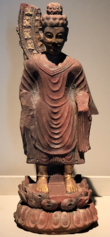
الديانات السائدة في سيتشوان هي الديانات الشعبية الصينية، التقاليد الطاوية، والبوذية الصينية. According to surveys conducted in 2007 and 2009, 10.6% of the population believes and is involved in cults of ancestors, while 0.68% of the population identifies as Christian.[58] According to the Japanese publication Tokyo Sentaku in 1999, there were 2 million members of Yiguandao (Tiandao) in Sichuan, equal to 2.4% of the province's population.[60]
The reports did not give figures for other types of religion; the vast majority of the population may be either irreligious or involved in the worship of nature deities, Buddhism, Confucianism, Taoism, folk religious sects, and small minorities of Muslims. Tibetan Buddhism is widespread, especially in areas inhabited by ethnic Tibetans. Sichuan is one of the cradles of the early Heavenly Masters' Taoist religious movements.
- المواقع الدينية في سيتشوان
منظر معبد التنين الأصفر (البوذية الصينية) في Huanglong.
A pavilion of the Shangqing Temple (Taoist) in Qingchengshan, Chengdu.
Golden Temple of Mount Emei (البوذية الصينية).
zh (Baba Mosque), a Chinese Sufi mosque in Langzhong.
الثقافة
The Sichuanese people (Sichuanese: 巴蜀人 Ba1su2ren2; IPA: [pa˥su˨˩zən˨˩]; alternatively 川人, 川渝人, 四川人 or 巴蜀民系) are a subgroup of Han Chinese living in mostly Sichuan province and the neighboring Chongqing municipality. Beginning from the 9th century BC, Shu (on the Chengdu Plain) and Ba (which had its first capital at Enshi City in Hubei and controlled part of the Han Valley) emerged as cultural and administrative centers where two rival kingdoms were established. Although eventually, the Qin dynasty destroyed the kingdoms of Shu and Ba, the Qin government accelerated the technological and agricultural advancements of Sichuan making it comparable to that of the Yellow River Valley. The now-extinct Ba–Shu language was derived from Qin-era settlers and represents the earliest documented division from what is now called Middle Chinese.
During the Yuan and Ming dynasties, the population of the area was reduced through wars and the bubonic plague, and settlers arrived from the area of modern Hubei, replacing the earlier common Chinese with a new standard.
The Li Bai Memorial, located in Jiangyou, is a museum in memory of Li Bai, a Chinese poet of Tang China (618–907) built at the place where he grew up. The building was begun in 1962 on the occasion of the 1200th anniversary of his death, completed in 1981, and opened to the public in October 1982. The memorial is built in the style of the classic Tang garden.
In 2003, Sichuan had "88 art performing troupes, 185 culture centers, 133 libraries, and 52 museums". Companies based in Sichuan also produced 23 television series and one film.[63]
اللغات
The Sichuanese once spoke their variety of Spoken Chinese called Ba-Shu Chinese, or Old Sichuanese before it became extinct during the Ming dynasty. Now most of them speak Sichuanese Mandarin. The Minjiang dialects are thought by some linguists[من؟] to be a bona fide descendant of Old Sichuanese, but there is no conclusive evidence whether Minjiang dialects are derived from Old Sichuanese or Southwestern Mandarin.[بحاجة لمصدر]
The languages of Sichuan are primarily members of three subfamilies of the Sino-Tibetan languages.
The most widely used variety of Chinese spoken in Sichuan is Sichuanese, which is the lingua franca in Sichuan, Chongqing, and parts of the Tibet Autonomous Region. Although Sichuanese is generally classified as a dialect of Mandarin Chinese, it is highly divergent in phonology, vocabulary, and even grammar from Standard Chinese.[64] The Minjiang dialect is especially difficult for speakers of other Mandarin dialects to understand.[65][66][67][68]
Garzê Tibetan Autonomous Prefecture and Ngawa Tibetan and Qiang Autonomous Prefecture in western Sichuan are populated by Tibetans and Qiang people. Tibetans speak the Khams and Amdo Tibetan, which are Tibetic languages, as well as various Qiangic languages. The Qiang speak Qiangic languages and often Tibetic languages as well. The Yi people of Liangshan Yi Autonomous Prefecture in southern Sichuan speak the Nuosu language, which is one of the Lolo-Burmese languages; Yi is written using the Yi script, a syllabary standardized in 1974. The Southwest University for Nationalities has one of China's most prominent Tibetology departments and the Southwest Minorities Publishing House prints literature in minority languages.[69] In the minority-inhabited regions of Sichuan, there is bilingual signage and public school instruction in non-Mandarin minority languages.
ديباج سيشوان

Commonly known as "Shu brocade" (蜀錦) in Chinese, Sichuan brocade is referred to as the "mother of brocade in China" given its age.[70] This technique of embroidery originates in the capital city of Chengdu during the time of the Ancient Kingdom of Shu. It enjoyed high popularity throughout the regions along the Silk Road, which stimulated an "exoticization" of the embroidery designs during the 1st millennium, with most of the patterns imported from Sogdia and other parts of Central Asia.[71] According to the Book of Sui, in the year 605 AD, the head of the Sichuan ateliers producing silks in the "western style" was a certain He Chou, a name which betrays his Sogdian origins.[72] Most of the silk products unearthed in Xinjiang (Chinese Turkestan) and Qinghai (Tuyuhun Kingdom) confirmed to be manufactured in Sichuan.[73]
المطبخ
Sichuan is well known for its spicy cuisine and use of Sichuan peppers due to its humid climate. The Sichuanese are proud of their cuisine, known as one of the Four Great Traditions of Chinese cuisine. The cuisine here is of "one dish, one shape, hundreds of dishes, hundreds of tastes", as the saying goes, to describe its acclaimed diversity. The most prominent traits of Sichuanese cuisine are described by four words: spicy, hot, fresh, and fragrant.[74] Sichuan cuisine is popular in the whole nation of China, and so are Sichuan chefs.
Another famous Sichuan cuisine is hot pot. Hot pot is a Chinese soup containing a variety of East Asian foodstuffs and ingredients, prepared with a simmering pot of soup stock at the dining table. While the hot pot is kept simmering, ingredients are placed into the pot and cooked at the table. Typical hot pot dishes include thinly sliced meat, leaf vegetables, mushrooms, wontons, egg dumplings, tofu, and seafood. The cooked food is usually eaten with a dipping sauce.
Kung Pao chicken, one of the best known dishes of Sichuan cuisine
Zha Jiang Noodles (杂酱面)
التعليم
الكليات والجامعات
As of 2022, Sichuan hosts 134 institutions of higher education, ranking first in the Western China region and fifth among all Chinese provinces after Jiangsu, Guangdong, Henan and Shandong.[75][76]
- Sichuan University (Chengdu)
- Southwest Jiaotong University (Chengdu)
- University of Electronic Science and Technology of China (Chengdu)
- Southwestern University of Finance and Economics (Chengdu)
- Chengdu University of Technology (Chengdu)
- Chengdu University of Information Technology (Chengdu)
- Chengdu University of Traditional Chinese Medicine (Chengdu)
- Civil Aviation Flight University of China (Guanghan)
- Southwest University for Nationalities (Chengdu)
- Sichuan Normal University (Chengdu)
- Sichuan Agricultural University (Ya'an, Chengdu, Dujiangyan)
- Southwest Petroleum University (Nanchong and Chengdu)
- Xihua University (Chengdu)
- Southwest University of Science and Technology (Mianyang)
- China West Normal University (Nanchong)
- North Sichuan Medical College (Nanchong)
- Panzhihua University (Panzhihua)
- Sichuan Police College (Luzhou)
- Sichuan University of Science and Engineering (Zigong and Yibin)
- Chengdu University (Chengdu)
- Xichang University (Xichang)
- Aba Teachers University (Ngawa Tibetan and Qiang Autonomous Prefecture)
السياحة
Waterfalls at Mount Qincheng
Bipenggou Valley
Mount Siguniang Scenic Area
Hailuogou Glacier Forest Park
UNESCO World Heritage Sites in Sichuan province and Chongqing municipality include:
- Dazu Rock Carvings and Wulong Karst (Chongqing municipality)
- Huanglong Scenic and Historic Interest Area
- Jiuzhaigou Valley Scenic and Historic Interest Area
- Mount Emei Scenic Area, including Leshan Giant Buddha Scenic Area
- Mount Qincheng and the Dujiangyan Irrigation System
- Sichuan Giant Panda Sanctuaries
As of July 2013, the world's largest building, the New Century Global Center is located in the city of Chengdu. At 328 ft (100 m) high, 1,640 ft (500 m) long, and 1,312 ft (400 m) wide, the Center houses retail outlets, a 14-theater cinema, offices, hotels, the Paradise Island waterpark, an artificial beach, a 164 yd (150 m)-long LED screen, skating rink, pirate ship, fake Mediterranean village, 24-hour artificial sun, and 15,000-spot parking area.[77]
قائمة اليونسكو للتراث العالمي
- Dazu Rock Carvings, listed as property of the Chongqing municipality
- Huanglong Scenic and Historic Interest Area
- Jiuzhaigou Valley Scenic and Historic Interest Area
- Mount Emei Scenic Area, including Leshan Giant Buddha Scenic Area
- Mount Qincheng and the Dujiangyan Irrigation System
- Sichuan Giant Panda Sanctuaries
الولايات والأقاليم الشقيقة
 Washington, United States (1982)
Washington, United States (1982) Michigan, United States (1982)
Michigan, United States (1982) Hiroshima Prefecture, Japan (1984)
Hiroshima Prefecture, Japan (1984) Yamanashi Prefecture, Japan (1985)
Yamanashi Prefecture, Japan (1985) South P'yŏngan, North Korea (1985)
South P'yŏngan, North Korea (1985) Midi-Pyrénées, France (1987)
Midi-Pyrénées, France (1987) North Rhine-Westphalia, Germany (1988)
North Rhine-Westphalia, Germany (1988) Leicestershire, United Kingdom (1988)
Leicestershire, United Kingdom (1988) Piedmont, Italy (1990)
Piedmont, Italy (1990) Pernambuco, Brazil (1992)
Pernambuco, Brazil (1992) Tolna County, Hungary (1993)
Tolna County, Hungary (1993) Valencian Community, Spain (1994)
Valencian Community, Spain (1994) Brussels-Capital Region, Belgium (1995)
Brussels-Capital Region, Belgium (1995) Barinas State, Venezuela (2001)
Barinas State, Venezuela (2001) Friesland, Netherlands (2001)
Friesland, Netherlands (2001) Almaty Province, Kazakhstan (2001)
Almaty Province, Kazakhstan (2001) Mpumalanga, South Africa (2002)
Mpumalanga, South Africa (2002) Suphan Buri, Thailand (2010)
Suphan Buri, Thailand (2010) Victoria, Australia (2015)
Victoria, Australia (2015) Lavalleja, Uruguay (2020)
Lavalleja, Uruguay (2020)
انظر أيضاً
ملاحظات
- ^ Si (四) means "four", Chuan (川) means "plain", and Xia ("峡") could be understood as "gorge". Sì Chuānlù and Chuānxiá Sìlù are general names for the Four Circuits,.
- ^ Some of the data collected by the Chinese General Social Survey (CGSS) of 2009 and by the Chinese Spiritual Life Survey (CSLS) of 2007 have been reported and assembled by Xiuhua Wang (2015)[58] in order to confront the proportion of people identifying with two similar social structures: ① Christian churches, and ② the traditional Chinese religion of the lineage (i. e. people believing and worshipping ancestral deities often organised into lineage "churches" and ancestral shrines). Data for other religions with a significant presence in China (deity cults, Buddhism, Taoism, folk religious sects, Islam, et al.) were not reported by Wang and come from different sources.
- ^ Based on a 2006 survey of the distribution of Buddhist institutions in China,[59] assuming that the percentage of institutions per capita is consistent with the percentage of Buddhists (which has been proved so by data on other regions), the Buddhist religion would account for between 10% and 20% (≈15%) of the population of Sichuan.
- ^ As of 2010 there are 11,200 Muslims in Sichuan.[61]
المصادر
- ^ "Doing Business in China – Survey". Ministry Of Commerce – People's Republic Of China. Archived from the original on 26 May 2014. Retrieved 5 August 2013.
- ^ "Communiqué of the Seventh National Population Census (No. 3)". National Bureau of Statistics of China. 11 May 2021. Archived from the original on 1 October 2021. Retrieved 11 May 2021.
- ^ "Sub-national HDI – Subnational HDI – Global Data Lab". globaldatalab.org. Archived from the original on 12 November 2020. Retrieved 2020-04-17.
- ^ The word chuān, 川 normally means "river", but here means "plains". The name "Sichuan" is an abbreviation of "the four plain circuits" The four circuits consist of Yizhou, Lizhou, Zizhou & Kuizhou.
- ^ "Sichuan". Lexico UK English Dictionary. Oxford University Press. Archived from the original on 13 January 2021.
- ^ أ ب "Decoding China's 2021 GDP Growth Rate: A Look at Regional Numbers". China Briefing News (in الإنجليزية). 2022-02-07. Archived from the original on 19 August 2022. Retrieved 2022-09-15.
- ^ أ ب "GDP (current US$) - Turkiye | Data". data.worldbank.org. Archived from the original on 15 September 2022. Retrieved 2022-09-15.
- ^ أ ب "GDP (current US$) | Data". data.worldbank.org. Archived from the original on 15 September 2022. Retrieved 2022-09-15.
- ^ Ruf, Gregory Anthony (1994), Pillars of the State: Laboring Families, Authority, and Community in Rural Sichuan, 1937–1991, New York: Columbia University Press, p. 68
- ^ Ancient Central China: Centers and Peripheries along the Yangzi River. Cambridge University Press. 21 January 2013. p. 26. ISBN 978-0521899000. Archived from the original on 18 January 2021. Retrieved 15 January 2019.
{{cite book}}: Cite uses deprecated parameter|authors=(help) - ^ 谭其骧; 王天良; 邹逸麟; 郑宝恒; 胡菊兴 (1980). 我国省区名称的来源 [Etymology of our country's provinces]. 《复旦学报(社会科学版)》 (S1): 128.
- ^ 张学君; 四川省地方志编纂委员会 (2003). 《四川省志·卷首》 [Annals of Sichuan Province, Volume 1]. Beijing: 方志出版社. p. 103. ISBN 7-80122-933-9.
- ^ (in صينية)Origin of the Names of China's Provinces Archived 27 أبريل 2016 at the Wayback Machine, People's Daily Online.
- ^ 牛汝辰 (2016). 《中国地名掌故词典》 [Dictionary of Etymology of Chinese Places]. Beijing: 中国社会出版社. p. 321. ISBN 978-7-5087-5238-9.
- ^ 贾文毓; 李引 (2005). 《中国地名辞源》 [Etymology of Chinese Places]. Beijing: Huaxia Publishing House. p. 360. ISBN 7-5080-3790-1.
- ^ Rowan K. Flad; Pochan Chen (2013). Ancient Central China: Centers and Peripheries Along the Yangzi River. Cambridge University Press. p. 71. ISBN 978-0521899000. Archived from the original on 20 January 2020. Retrieved 15 January 2019.
- ^ Historical Geographical Characteristics. Archived from the original on 19 August 2012. Retrieved 16 January 2019.
{{cite book}}:|work=ignored (help) - ^ Anne P. Underhill, ed. (2013). "Chapter 7: The Sichuan Basin Neolithic – The Baodun Culture". A Companion to Chinese Archaeology. Wiley. ISBN 978-1-118-32578-0. Archived from the original on 14 January 2020. Retrieved 16 January 2019.
- ^ Ancient Central China: Centers and Peripheries Along the Yangzi River. Cambridge University Press. 2013. p. 74. ISBN 978-0521899000. Archived from the original on 26 January 2021. Retrieved 16 January 2019.
{{cite book}}: Cite uses deprecated parameter|authors=(help) - ^ أ ب Steven F. Sage (2006). Ancient Sichuan and the Unification of China. State University of New York Press. pp. 2–3. ISBN 0-7914-1038-2. Archived from the original on 30 January 2022. Retrieved 10 March 2016.
- ^ Shujing Archived 17 نوفمبر 2015 at the Wayback Machine Original text: 王曰:「嗟!我友邦塚君御事,司徒、司鄧、司空,亞旅、師氏,千夫長、百夫長,及庸,蜀、羌、髳、微、盧、彭、濮人。稱爾戈,比爾干,立爾矛,予其誓。」
- ^ Sanxingdui Museum; Wu Weixi; Zhu Yarong (2006). The Sanxingdui site: mystical mask on ancient Shu Kingdom. China Intercontinental Press. pp. 7–8. ISBN 7-5085-0852-1. Archived from the original on 30 January 2022. Retrieved 10 March 2016.
- ^ Chang Qu. 卷三 [Book 3]. 華陽國志 [Chronicles of Huayang]. pp. 90–91. Archived from the original on 14 March 2016. Retrieved 15 November 2015.
- ^ Sun Hua (2013). "Chapter 8: The Sanxingdui Culture of Sichuan". In Anne P. Underhill (ed.). A Companion to Chinese Archaeology. Wiley. ISBN 978-1-118-32578-0. Archived from the original on 17 January 2020. Retrieved 15 January 2019.
- ^ أ ب Terry F. Kleeman (1998). Ta Chʻeng, Great Perfection – Religion and Ethnicity in a Chinese Millennial Kingdom. University of Hawaii Press. pp. 17–19, 22. ISBN 0-8248-1800-8. Archived from the original on 30 January 2022. Retrieved 10 March 2016.
- ^ Sanxingdui Museum; Wu Weixi; Zhu Yarong (2006). The Sanxingdui site: mystical mask on ancient Shu Kingdom. China Intercontinental Press. pp. 5–6. ISBN 7-5085-0852-1. Archived from the original on 30 January 2022. Retrieved 10 March 2016.
- ^ أ ب Haw, Stephen G (2008). A Traveller's History of China. Interlink Books. p. 83.
- ^ أ ب Boland-Crewe, Tara; Lea, David (2004). The Territories of the People's Republic of China. Psychology Press. pp. 187–189.
- ^ Horesh Niv , 2012, "From Chengdu to Stockholm: A Comparative Study of the Emergence of Paper Money in East and West"
- ^ Hans G.Wiedemann & Gerhard Bayer, 1992, "Approach to ancient Chinese artifacts by means of thermal analysis", Elsevier Science Publishers B.V., Amsterdam
- ^ Pan Jixing, 1998, "On the origin of movable metal-type technique", Chinese Science Bulletin
- ^ Fei, Xiaotong (2017-12-18). "The formation and development of the Chinese nation with multi-ethnic groups". International Journal of Anthropology and Ethnology. 1 (1): 1. doi:10.1186/s41257-017-0001-z. ISSN 2366-1003.
{{cite journal}}: CS1 maint: unflagged free DOI (link) - ^ Roberts, John A.G. (2011). A History of China. Palgrave Essential Histories series. Palgrave Macmillan. p. 109. ISBN 978-0-230-34536-2. Archived from the original on 4 June 2016. Retrieved 15 November 2015.
- ^ Yu, Songnian (1840). Yi jia tang cong shu 成都录. Archived from the original on 13 May 2022. Retrieved 18 October 2020.
城中骸骨一百四十万
- ^ 李心傳 [Li Xinchuan], "建炎以來朝野雜記", 文海出版公司 [Wenhai Publishing Co.], 1967. 1st set,section 7, page 15
- ^ 李心傳 [Li Xinchuan], "建炎以來朝野雜記", 文海出版公司 [Wenhai Publishing Co.], 1967. 1st set,section 7, page 16
- ^ C. P. Atwood-Encyclopedia of Mongolia and the Mongol Empire
- ^ Ebrey, Patricia Buckley; Smith, Paul Jakov (25 August 2016). State Power in China, 900–1325. p. 325. ISBN 9780295998480. Archived from the original on 12 January 2020. Retrieved 19 August 2019.
- ^ [1] Archived 1 مايو 2018 at the Wayback Machine, Survey in Minshang Mountains by Michel
- ^ [2] Archived 24 أبريل 2018 at the Wayback Machine, Panda Symbolism by Elena Harris.
- ^ 中华人民共和国县以上行政区划代码 (in الصينية المبسطة). Ministry of Civil Affairs. Archived from the original on 2 April 2015. Retrieved 11 December 2015.
- ^ Shenzhen Bureau of Statistics. 《深圳统计年鉴2014》 (in الصينية المبسطة). China Statistics Print. Archived from the original on 12 May 2015. Retrieved 2015-05-29.
- ^ Census Office of the State Council of the People's Republic of China; Population and Employment Statistics Division of the National Bureau of Statistics of the People's Republic of China (2012). 中国2010人口普查分乡、镇、街道资料 (1 ed.). Beijing: China Statistics Print. ISBN 978-7-5037-6660-2.
- ^ Ministry of Civil Affairs (August 2014). 《中国民政统计年鉴2014》 (in الصينية المبسطة). China Statistics Print. ISBN 978-7-5037-7130-9.
- ^ "中国统计年鉴—2018". Archived from the original on 6 January 2019. Retrieved 28 January 2019.
- ^ أ ب ت 国务院人口普查办公室、国家统计局人口和社会科技统计司编 (2012). 中国2010年人口普查分县资料. Beijing: China Statistics Print. ISBN 978-7-5037-6659-6.
- ^ "Decoding China's 2021 GDP Growth Rate: A Look at Regional Numbers". China Briefing News (in الإنجليزية). 2022-02-07. Archived from the original on 19 August 2022. Retrieved 2022-09-15.
- ^ سيتشوان, الموسوعة العربية
- ^ "SICHUAN PROVINCE (hktdc.com)". Archived from the original on 8 February 2006. Retrieved 5 February 2006.
- ^ خطأ استشهاد: وسم
<ref>غير صحيح؛ لا نص تم توفيره للمراجع المسماةbare_url - ^ "International Market Research – AUTO PARTS INDUSTRY IN SICHUAN AND CHONGQING". Archived from the original on 26 June 2006. Retrieved 5 February 2006.
- ^ "Chengdu Economic & Technological Development Zone". RightSite.asia. Archived from the original on 7 May 2010. Retrieved 2011-03-15.
- ^ "Chengdu Export Processing Zone". RightSite.asia. Archived from the original on 5 May 2010. Retrieved 2011-03-15.
- ^ "Chengdu Hi-Tech Industrial Development Zone". RightSite.asia. Archived from the original on 20 June 2010. Retrieved 2011-03-15.
- ^ "RightSite.asia | Mianyang Hi-Tech Industrial Development Zone". Archived from the original on 5 May 2010. Retrieved 21 July 2010.
- ^ "Tibetans leave home to seek new opportunities". Xinhua. 2012-03-14. Archived from the original on 7 April 2012. Retrieved 2014-01-04.
- ^ Roberts, Edmund (1837). Embassy to the Eastern Courts of Cochin-China, Siam, and Muscat. New York: Harper & Brothers. p. 123. Archived from the original on 16 October 2013. Retrieved 16 October 2013.
- ^ أ ب ت China General Social Survey (CGSS) 2009, Chinese Spiritual Life Survey (CSLS) 2007. Report by: Xiuhua Wang (2015, p. 15) Archived 25 سبتمبر 2015 at the Wayback Machine
- ^ Ji, Zhe (2011). 复兴三十年:当代中国佛教的基本数据 [Three Decades of Revival: Basic Data on Contemporary Chinese Buddhism]. fjzd.org [China Buddhism System Research Center] (in الصينية المبسطة). Archived from the original on 27 April 2017. Retrieved 18 September 2016.
- ^ أ ب Tokyo Sentaku [in Japanese]. 1 June 1999. "Cult Groups Seen Shaking Party Leadership" (FBIS-CHI-1999-0614 1 June 1999/WNC). Cited in: ecoi.net, The Tian Dao (Yi Guan Dao, Yiguandao, Yi Guandao) sect and treatment of believers by the authorities Archived 9 أكتوبر 2016 at the Wayback Machine. [CHN32887.E] [ID 171890].
- ^ Min Junqing. The Present Situation and Characteristics of Contemporary Islam in China. JISMOR, 8. 2010 Islam by province, page 29 Archived 27 أبريل 2017 at the Wayback Machine. Data from: Yang Zongde, Study on Current Muslim Population in China, Jinan Muslim, 2, 2010.
- ^ Howard, Angela F. (2008). "Pluralism of Styles in Sixth-Century China: A Reaffirmation of Indian Models". Ars Orientalis. 35: 67. JSTOR 25481908.
- ^ Catherine, ed. (2004-05-26). "Sichuan: Education and Culture". newsgd.com. Archived from the original on 14 May 2015. Retrieved 2014-01-04.
- ^ Cui, Rongchang (崔荣昌) (1996). 第三章:四川的官话. 《四川方言与巴蜀文化》 (in الصينية المبسطة). Sichuan University Press. ISBN 7-5614-1296-7.
- ^ Li, Bin (李彬); Tu, Minghua (涂鸣华) (2007). 《百年中国新闻人(上册)》 (in الصينية المبسطة). Fujian People's Press. p. 563. ISBN 978-7-211-05482-4.
- ^ Wu, Dan (吴丹); Liang, Xiaoming (梁晓明) (23 November 2005). 四川交通:"窗口"飞来普通话. 中国交通报 (in الصينية المبسطة).
- ^ Zhang, Guosheng (张国盛); Yu, Yong (余勇) (1 June 2009). 大学生村官恶补四川方言 现在能用流利四川话和村民交流. Morning Post (in الصينية المبسطة).
- ^ 走进大山的志愿者. 四川青年报 [Sichuan Youth Paper] (in الصينية المبسطة). 18 July 2009.
- ^ "The Wuhou District (武侯区), a Tibetan enclave in Chengdu". TibetInfoNet. 2009-03-24. ISSN 1864-1407. Archived from the original on 5 January 2014. Retrieved 2013-01-04.
- ^ Wang, Yeting (2018). "Road Heritage: Ancient and Modern Shu brocade and Southern Silk Road". Revista de Arquitetura IMED. 7 (1): 165. doi:10.18256/2318-1109.2018.v7i1.2933. Retrieved March 17, 2023.
- ^ Cheng, Si; Qiao, Hong (2022). "唐代蜀锦团窠纹的审美特征" [Aesthetic Characteristics of Tuanke Pattern of Shu Brocade in Tang Dynasty] (PDF). Progress in Textile Science & Technology (in الصينية المبسطة). Chengdu: Sichuan Textile Science & Technology Intelligence Center; Sichuan Textile Engineering Academy. p. 56. Retrieved March 17, 2023.
- ^ Compareti, Matteo (2003). "The role of the Sogdian Colonies in the diffusion of the pearl roundels pattern". transoxiana.org. Retrieved March 17, 2023.
- ^ "凭什么说新疆、青海出土的锦,好多都是蜀锦?" [Why are most of the brocades unearthed in Xinjiang and Qinghai made in Sichuan?]. cdmuseum.com (in الصينية المبسطة). December 2, 2017. Retrieved March 17, 2023.
- ^ Sichuanese Cuisine Archived 20 يوليو 2008 at the Wayback Machine (in صينية) – Pictures, descriptions, history, and examples of Sichuan cuisine.
- ^ "全国普通高等学校名单 - 中华人民共和国教育部政府门户网站". hudong.moe.gov.cn. Retrieved 2022-06-18.
- ^ "全国高等学校名单 - 中华人民共和国教育部政府门户网站". www.moe.gov.cn. Retrieved 2022-06-18.
- ^ Roberto A. Ferdman (3 July 2013). "The world's new largest building is four times the size of Vatican City". Quartz. Quartz. Archived from the original on 4 July 2013. Retrieved 4 July 2013.
وصلات خارجية
- Official website
- Economic profile for Sichuan at HKTDC
 Geographic data related to سيتشوان at OpenStreetMap
Geographic data related to سيتشوان at OpenStreetMap
- Pages using gadget WikiMiniAtlas
- Articles containing صينية-language text
- CS1 errors: deprecated parameters
- CS1 uses الصينية-language script (zh)
- Articles with صينية-language sources (zh)
- CS1 errors: periodical ignored
- CS1 maint: unflagged free DOI
- CS1 الصينية المبسطة-language sources (zh-hans)
- Short description is different from Wikidata
- Coordinates on Wikidata
- Articles containing Yi-language text
- مقالات تحتوي نصوصاً باللغة الصينية
- Articles with unsourced statements from June 2015
- Articles with unsourced statements from April 2020
- مقالات تحتوي نصوصاً باللغة الصينية التقليدية
- Articles with unsourced statements from June 2021
- Articles with unsourced statements from August 2017
- Articles with hatnote templates targeting a nonexistent page
- مقالات تحتوي نصوصاً باللغة الصينية المبسطة
- جميع المقالات الحاوية على عبارات مبهمة
- جميع المقالات الحاوية على عبارات مبهمة from March 2019
- Articles with unsourced statements from March 2019
- Official website different in Wikidata and Wikipedia
- سيچوان
- غرب الصين
- مقاطعات جمهورية الصين الشعبية





